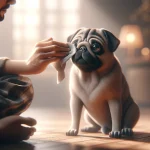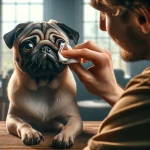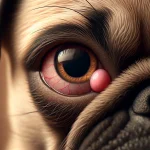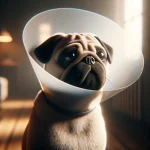Table of Contents
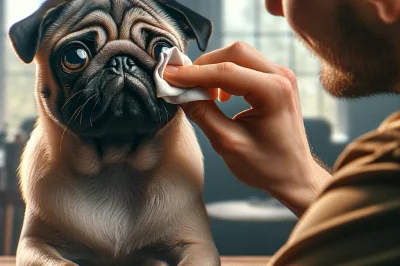
Key Takeaways
- Pug tear stains are common and can often be managed with the right products and care.
- Before using any tear stain remover, it’s crucial to consult with a vet to rule out underlying health issues.
- Natural ingredient-based removers are a safe choice for pugs with sensitive skin and eyes.
- Regular grooming and dietary adjustments can help maintain your pug’s eye health and prevent tear stains.
- It’s important to be gentle when applying tear stain removers and to follow product instructions carefully.
Tackling Pug Tear Stains: A Pet Owner’s Guide
As a pug owner, you’re probably familiar with the distinctive face and expressive eyes that make this breed so lovable. But along with those adorable features can come tear stains – those reddish-brown marks that often appear below their eyes. Not only can these stains affect the appearance of your furry friend, but they can also be a sign of underlying health issues. That’s why finding a safe and effective tear stain remover is essential for maintaining your pug’s eye health and keeping them looking their best.
Understanding Tear Stains in Pugs
Tear stains are a common issue among pugs due to their facial structure. The wrinkles and short nasal passages can lead to excess tearing and moisture, which creates a breeding ground for bacteria and yeast. This, in turn, can cause those noticeable stains on their light-colored fur. But there’s good news: with proper care and the right products, managing these stains is entirely possible.
It’s important to understand that tear staining can have multiple causes, including diet, water quality, allergies, and blocked tear ducts. Because of this, it’s not just about wiping away the stains – it’s about addressing the root cause. Sometimes, simple changes like using filtered water or adjusting your pug’s diet can make a significant difference.
When to Seek Veterinary Advice
Before you start shopping for tear stain removers, it’s essential to consult with your veterinarian. They can help determine if there’s a medical reason for the excessive tearing, such as an infection or an anatomical issue that may require treatment. Besides that, your vet can offer advice on products that are safe and suitable for your pug’s specific needs.
Most importantly, remember that tear stains can sometimes indicate a more serious health problem. If you notice any changes in your pug’s eyes or behavior, such as increased tearing, redness, or rubbing their face, it’s time for a vet visit.
Top Picks for Pug Tear Stain Removers
Finding the best tear stain remover for your pug can feel overwhelming with so many options available. To help you make an informed decision, I’ve compiled a list of top picks that prioritize safety and effectiveness. These products have been selected based on their gentle formulas, positive reviews, and suitability for the sensitive eye area of pugs.
Natural Ingredient-Based Removers
Natural removers are often the go-to choice for pug owners, as they typically contain gentle ingredients like chamomile, cucumber, or witch hazel. These ingredients can soothe the skin while helping to lighten stains.
Chemical-Free Formulas
Chemical-free formulas are crucial for the delicate eye area. Look for products that are free from parabens, sulfates, and fragrances, which can irritate your pug’s skin and eyes.
Gentle Solutions for Sensitive Pug Eyes
When it comes to your pug’s eyes, gentleness is key. Solutions that are specifically designed for sensitive eyes will help ensure that the cleaning process is comfortable and safe for your pet.
Choosing the right tear stain remover is just the first step. To ensure you get the best results, you need to apply the product correctly. Start by reading the instructions on the label carefully. Each product may have its own specific application process, but there are some general tips that can help.
Application Tips for Best Results
First, gather all the supplies you’ll need: the tear stain remover, cotton balls or pads, and a towel. Make sure your pug is comfortable and calm before you begin. You might want to do this after they’ve had a walk and are tired out. Dampen the cotton ball or pad with the remover and gently wipe the stained area, being careful not to touch the eye itself. After application, use the towel to dry the area to prevent any dampness, which can lead to more staining. Repeat this process daily until you see improvement.
Product Reviews and Recommendations
- Natural Pug’s Eye Elixir: This all-natural solution uses ingredients like coconut and lemon to safely clean and brighten your pug’s eye area.
- Pug’s Gentle Eye Rescue: Free from harsh chemicals, this formula is perfect for pugs with sensitive skin, using aloe vera and saline to soothe and cleanse.
- Happy Pug Tearless Tonic: This tear stain remover promises results with a gentle hypoallergenic formula suitable for regular use.
After using these products, many owners report seeing a noticeable difference in the appearance of their pug’s tear stains. Remember, consistency is key. You’ll need to apply the tear stain remover regularly to maintain the results. For more detailed information on maintaining your pug’s eye health, visit our comprehensive guide on Pug Peepers: A Comprehensive Guide to Eye Health and Conditions.
While these products can be effective, they’re not a substitute for proper veterinary care if your pug’s tear stains are due to a health issue. Always consult your vet if you’re concerned about your pug’s eye health.
Now, let’s talk about maintaining your pug’s eye health beyond just using tear stain removers. A combination of diet, grooming, and environmental factors plays a role in preventing those pesky stains from developing in the first place.
| Aspect | Pug Tear Stains |
|---|---|
| Root Cause | – Genetics: Selective breeding leading to short noses and protruding eyes with narrow tear ducts[1][3] |
| – Health Issues: Ingrown eyelashes, large tear-producing glands, small tear duct openings, stress, etc. | |
| Treatment | – Proper grooming: Regular face cleaning, keeping hair around eyes trimmed short[4][5] |
| – Dietary adjustments: High-quality, grain-free diet to prevent allergic reactions and excess tearing | |
| – Water quality: Use purified or distilled water to avoid excess minerals that can contribute to staining | |
| – Supplements: Probiotic enzymes, mild antibiotics under vet supervision, tear stain removal products | |
| Post-Treatment | – Regular maintenance: Daily eye and mouth hair hygiene to prevent recurrence of tear stains[3][5] |
| – Monitoring: Watch for signs of resurgence or underlying health issues, consult vet if needed |
Maintenance Beyond Tear Stain Removers
Preventing tear stains from occurring is always better than treating them after the fact. Regular maintenance can go a long way in keeping your pug’s eyes clean and healthy. This includes dietary adjustments, consistent grooming routines, and managing environmental factors and allergens.
Dietary Adjustments for Eye Health
Believe it or not, your pug’s diet can impact their tear staining. Foods that are high in grains and fillers can sometimes contribute to the problem. Instead, opt for high-quality, grain-free food that’s rich in natural ingredients. Adding a teaspoon of apple cider vinegar to their water can also help alter the pH of their tears, making the area less hospitable to bacteria and yeast that cause staining.
Make sure your pug has access to fresh water at all times. Changing the water regularly and using a stainless steel bowl can also help reduce the risk of tear stains.
Consistent Grooming Routines
Grooming isn’t just about keeping your pug looking good; it’s about maintaining their health too. Regularly cleaning the face and eye area can prevent the buildup of tears and reduce staining. Use a soft, damp cloth to gently wipe around the eyes every day. If your pug has particularly long hair around their eyes, you might consider trimming it to prevent irritation and accumulation of tears.
Environmental Factors and Allergens
Allergens in your pug’s environment can contribute to eye irritation and excessive tearing. Pay attention to when the tearing seems to worsen – is it during a particular season or after using certain cleaning products? Minimizing your pug’s exposure to these allergens can help reduce tear stains.
Common Questions on Pug Eye Care
Caring for your pug’s eyes may raise some questions, especially if you’re new to the breed or if you’ve noticed a recent increase in tear staining. Here are some common questions and answers to help you navigate your pug’s eye care.
How Often Should I Clean My Pug’s Eyes?
Most pugs benefit from daily eye cleaning. This helps to remove any debris or buildup that could lead to staining. If your pug is prone to tear stains, you might need to clean around their eyes twice a day – once in the morning and once in the evening.
However, every pug is different, and some may require more or less frequent cleaning. Observe your pug’s condition and adjust your routine accordingly.
Canine grooming isn’t just a matter of aesthetics; it’s integral to their health, especially for breeds like pugs that may have specific needs due to their unique facial structure. So, when it comes to the fur around their eyes, is it safe to trim it? Absolutely, but it must be done with care. Shortening the hair can prevent it from irritating your pug’s eyes and reduce the risk of tear stains. Use rounded-tip scissors and work in a well-lit area to carefully trim the hair, or better yet, have a professional groomer do it for you.
What Steps Can Prevent Tear Stains from Forming?
Prevention is always better than cure, and this holds true for managing tear stains in pugs. Keep the fur around their eyes trimmed, provide a high-quality diet, and ensure they always have fresh water. Regularly clean their face with a damp cloth, and consider adding a tear stain prevention supplement to their routine if your vet agrees. Lastly, keep their environment free from irritants that could cause excessive tearing.
Final Thoughts: Keeping Your Pug’s Eyes Bright and Healthy
As pug owners, we adore our pets’ soulful eyes and want to keep them as expressive and clear as possible. The right tear stain remover can be a game-changer, but it’s just one part of a holistic approach to eye care. Regular check-ups with your vet, a balanced diet, and a consistent grooming routine will go a long way in keeping your pug’s eyes bright and healthy.
Frequently Asked Questions (FAQ)
Even with the best care, pug owners often have questions about maintaining their pet’s eye health. Here are some of the most frequently asked questions and their answers.
- Regular eye cleaning is essential for preventing tear stains.
- Consult your vet before using any new tear stain remover.
- A high-quality diet and clean water can help reduce tear staining.
- Trimming the fur around your pug’s eyes can prevent irritation and stains.
- Always monitor your pug for any adverse reactions to eye care products.
Can I use human eye care products on my Pug?
It’s not recommended to use human eye care products on your pug. Dogs have different pH levels and may react negatively to products formulated for humans. Always use products specifically designed for canine use to ensure safety and efficacy.
How long does it take for tear stain removers to work?
The effectiveness of tear stain removers can vary. Some owners see improvements within a few days, while others may not notice a change for several weeks. Consistent application is key, and if you don’t see any improvement after a month, consult your vet for further advice.
Are tear stain removers safe for puppies?
Many tear stain removers are safe for puppies, but it’s crucial to read the label and consult with your veterinarian. Puppies have sensitive skin, and you’ll want to ensure that any product you use is gentle enough for their delicate eye area.
What should I do if my Pug reacts badly to a tear stain remover?
If your pug has an adverse reaction to a tear stain remover, such as redness, irritation, or discomfort, stop using the product immediately. Clean the area with water to remove any residue and contact your vet for advice. They may recommend a different product or provide treatment if necessary.

